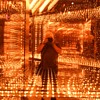Posted 12 years ago
PTRobins
(1 item)
In the 1880s a biologist from Holland worked in West Africa. He obtained about 50 images. Some were published in 1890. Many of his glass plates were destroyed in a cargo accident returning to Europe. The photographic apparatus was borrowed from an affluent citizen in Amsterdam. We have a letter of appreciation to the lender, to whom he sent a set of the obtained prints. The apparatus is never named or described. In examining one of the photos, we believe that the camera captured its own image in a mirror. What do you think? Can anyone recognize this device? The mirror shows a window frame, the back of a clock figurine, a rattan chair back and a rectangular box. If you enlarge the image, you may even suspect that a faint image of a round lens is visible. The book associated with this work was just translated into English from German and is at the following Google link. Thanks for any ideas about determining the nature of the camera.
http://books.google.com/books?id=UsoIHEElvlIC&printsec=frontcover&source=gbs_ge_summary_r&cad=0#v=onepage&q&f=false
See other photos in this series at: http://uk.dir.groups.yahoo.com/group/Idaman_Group/message/53956
but don't rely on the captions translations, some of which are flawed.
Best regards,
Phillip Robinson, Co-Author of Travel Sketches from Liberia
University of Toledo
philliip.robinson@utoledo.edu
http://www.brill.com/travel-sketches-liberia













The image in the mirror (unfortunately) is not a camera. Additionally, the angle of view is incapable for the camera to have taken its own picture. The item in the mirror is located on a wall to the right of the camera. The position of the image purposely avoided including the camera and photographer. My best guess is that the item on the stand might be a case for stereo viewer or similar ... but that's only speculation. Nice image.
Nice Photo! I like the Brass Oil Lamp on the Ceiling with the Milk Glass Shade & Smoke Bell and the Calling Bell on the table. What are the two tri-footed pieces of furniture near the chair on the right and another on the back left. Were they heat or draft deflectors or something used for doing petit point by the ladies? The wicker chairs seem out of place but do provide a more cozy atmosphere to a pretty drab setting otherwise. RER (LOUMANAL)
Thanks for the comments. They are much appreciated. In particular the angles involved. In regard to the tri-footed pieces in the parlor, I believe these are probably the needlework devices used by the lady of the house, Mrs. Modderman. This photo would have been from 1886. It is very stimulating to examine the furnishings of a room such as this since I have seen no others from this tropical city where indoor lighting was a challenge and cameras were few. The large and numerous windows were very practical for ventilation and light. Unfortunately, the lack of screens gave access to mosquitoes which had the potential for transmitting malaria. -Phil